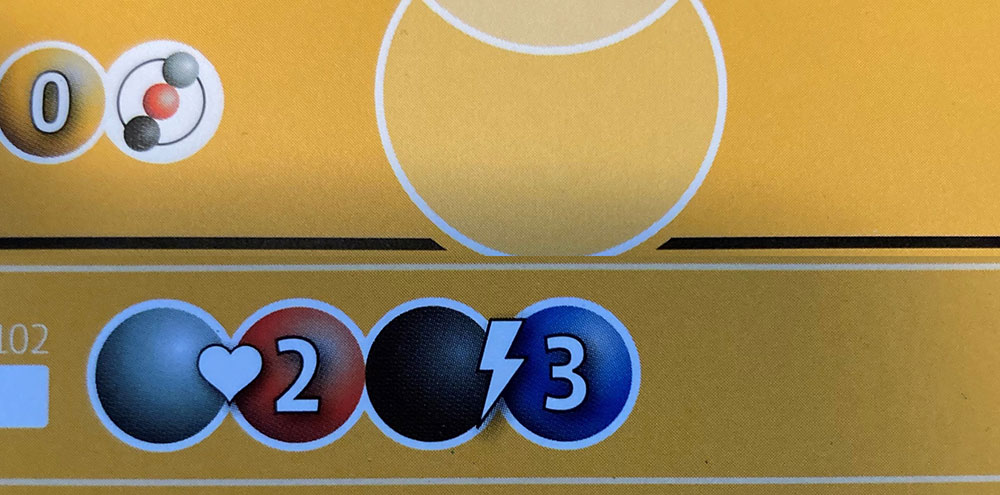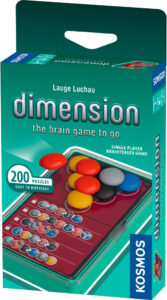 On a whim at Dice Tower West last year, my wife signed up for two tournaments of games she’d never played before. She won silver in one (Wordsy) and did reasonably well in a game called Dimension designed by Lauge Luchau. She liked Dimension so much she authorized me to get a copy from Germany, and we’ve played it a bunch since then. So when the folks at Kosmos asked me to review a portable, solo version called Dimension: The Brain Game To Go by the same designer (I’ll just call it Dimension: To Go), I jumped at the chance to tell you all whether this chip off the old block can equal the fun of its parent.
On a whim at Dice Tower West last year, my wife signed up for two tournaments of games she’d never played before. She won silver in one (Wordsy) and did reasonably well in a game called Dimension designed by Lauge Luchau. She liked Dimension so much she authorized me to get a copy from Germany, and we’ve played it a bunch since then. So when the folks at Kosmos asked me to review a portable, solo version called Dimension: The Brain Game To Go by the same designer (I’ll just call it Dimension: To Go), I jumped at the chance to tell you all whether this chip off the old block can equal the fun of its parent.
Gameplay Overview:
Dimension: To Go is a solo game for ages 8 and up, and the box correctly explains that each game lasts about five minutes. What the box fails to tell you is that after solving the first easy puzzle on any of the 20 cards (each with five puzzles per side), you’ll immediately want to dive into another, so “just one more” can find you 30 minutes in, before you realize you probably should get back to whatever it was you were hoping for a five-minute break from.
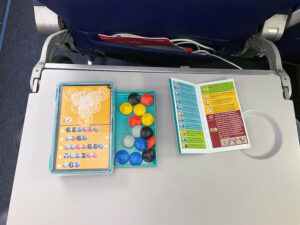
That’s Dimension: To Go at its best. You have 15 pleasant-to-touch, brightly colored discs (three each of five colors) with small indents around the edges, 20 cards with 10 puzzle-challenges on each card, and a convenient green plastic holder that doubles as the playing surface. The moment I saw it, I thought “this would be great to play on an airplane” and so that is how I decided to playtest this game.
The idea behind the game is you are given a series of logical rules and then need to assemble ten of the discs (occasionally fewer) into a pyramid such that all of the rules are respected. You can then check your work against the tiny printed solution included for all 200 puzzles in the manual, and if you’re right, you can go on to the next one. Even at five-minutes each, the full set of 200 puzzles will last for a long flight, though beware of turbulence.
Game Experience:
While Dimension: To Go is a stand-alone experience, it’s hard to imagine really enjoying this game if I had not played a lot of Dimension, its parent game. That game has many of the same elements: logic puzzles to solve, pleasantly tactile components, and bright colors, but it is a competitive game, and it adds a timer to create hectic fun. It’s not quite a dexterity game, but getting the balls to stack up properly without knocking them over can be a challenge for the clumsy (it me!), perhaps unintended by the designers.
So, first, a quick explanation of the original Dimension. Play starts by drawing six random cards for each round, each with a logical condition on it that uses a set of symbols to explain the logical rules. Players then flip over an egg timer and do their best to stack their balls, as it were. If you get none, you lose six points, if you get all six you get six points, with lesser penalties or rewards in between. The timer seems to go fastest when you’re closing in on a perfect score, but everyone is usually happy to check their efforts, knock down the pyramids, and start another round. It’s superb.
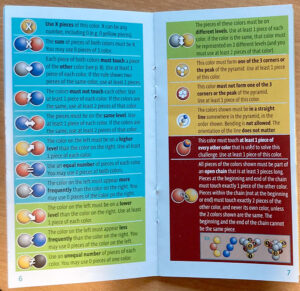
What “Dimension: To Go” tries to do is to take this boisterous, time-is-running-out, competitive logic puzzle and get it to work as a meditative, go-at-your-own pace, solo game. Gone is the egg timer, the large balls, and the simple-to-understand logical conditions. Instead of fifteen non-slip plastic balls, you get 15 slippery plastic discs. Instead of six random logical conditions in the form of easily read cards, you get twenty tarot-sized cards with five very small puzzles on each side. And without opponents to verify how many of the conditions you’ve met, you simply solve each puzzle on your own and compare it to a tiny list of solutions in the manual that fits neatly in the game’s plastic carrying case.
If that sounds less fun, it’s because it is. It’s not un-fun, but it’s a much more /golfclap kind of game, where Dimension has a vibe like a strobe-light introduction at a basketball game. This stood out the most when I wanted to check my work, because instead of getting “attaboy” or “well played” from fellow players, Dimension relied on me to decide if my answer matched the one in the rulebook and then cheer silently to myself.
I also found the logical schematics in Dimension: To Go harder to fully process than in Ur-Dimension. I was presented with two tiny pages of rules and had to interpret a long string of rules based on these symbols:
Please note, there are some very mild spoilers in what follows for one of the 200 puzzles, puzzle 11a-2.
An example will help show what I mean. On the 11th card, I was given this specific requirement for puzzle 2:
I interpreted these symbols to mean: No yellow balls at all, I needed to have black-orange-gray in a straight line of balls, and then I needed each grey ball to touch 2 orange balls, no black touching blue, and I needed at least 3 blue. (Another requirement off to the side just outside this photo made it clear I needed to use exactly 8 balls, instead of the default 10.) I wasn’t sure if Orange/Black had rules between them or not; as best I could tell, the absence of an icon at their point of intersection meant, no, I was free to ignore any constraints for orange vis-à-vis black and vice versa. So I solved the puzzle, or so I though, like this:
Both of the gray pieces touched exactly two oranges. None of the three blues touch the black piece. No yellows. And along the top I had a line of black-orange-gray, as instructed. And I used exactly 8 discs. So Yay!
When I turned to the answer sheet, I saw this:
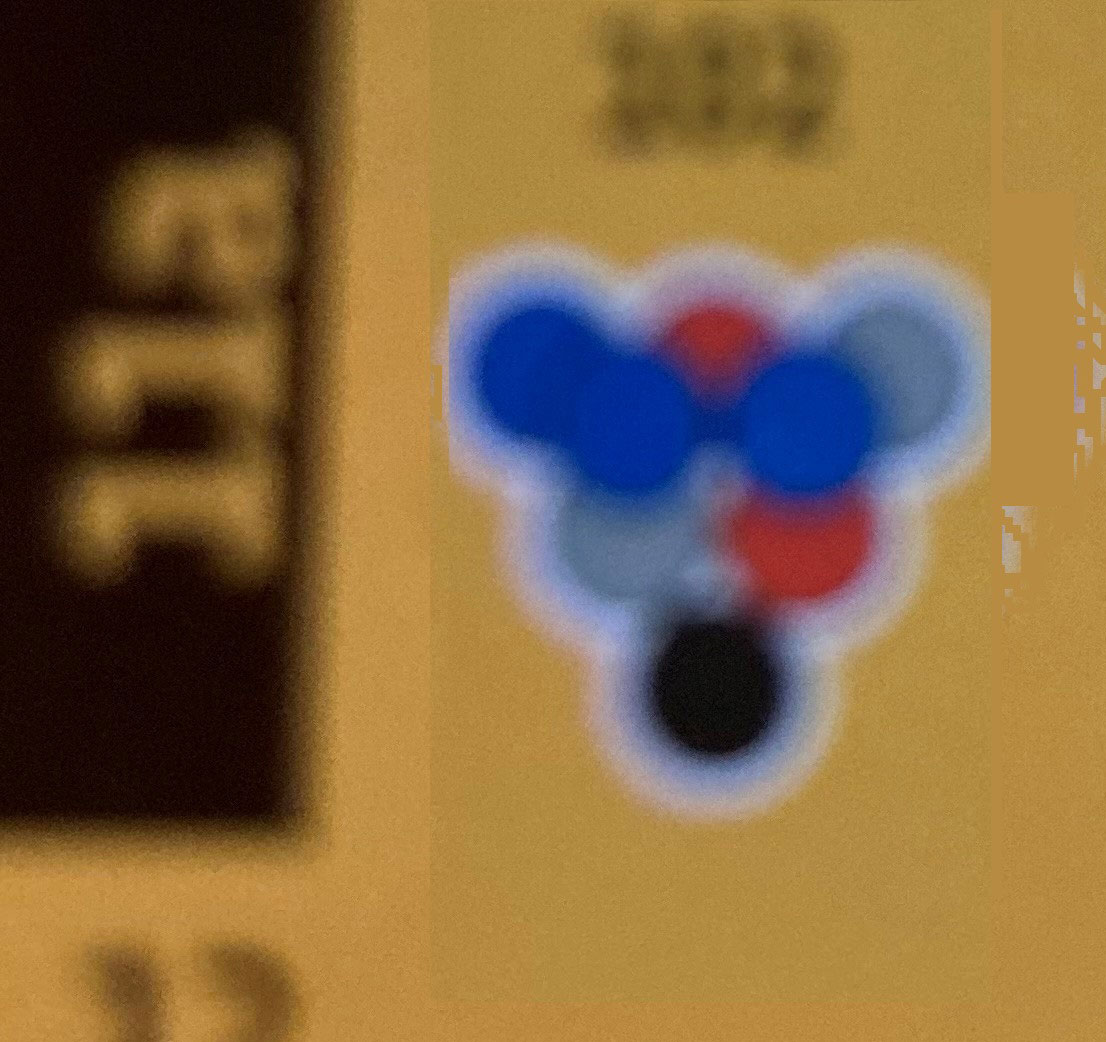
After turning my answer around to orient it like the version in the book, I was eventually able to confirm I had the same thing, but it took me almost as long to check my work as to solve the puzzle in the first place. And since I was sitting on the airplane next to strangers, there was no non-nerdly way to verify what I thought I saw or to celebrate my success with anyone.
That said, I dove right back into more puzzles, and I was having a good time as we flew towards my destination until—dramatic sound effects—we hit some serious turbulence. I had two discs in my hand as the plane lurched downward and bounced back up. Those two discs went flying across the cabin. Two kind souls retrieved them from under their seats for me, and I confirmed that the rest of the discs, which had spilled onto my lap, were all present and accounted for, but I had to put the game away because I was too clearly clumsy to hold these pieces other than in placid skies.
Dimension: To Go is not Dimension by a long shot. It’s really not a competitor at all—you’d never pick the pocket version over the real thing if you had the choice. But as a portable, traveling-alone way to pass time, it is a nice little game. In truth, it’s the perfect game when you’re stuck on a long plane flight, except I wish I had been with a friend who could have checked my work and commended my efforts, and I really wish the pieces were not liable to become lethal projectiles under adverse weather conditions.
Final Thoughts:
By all means, buy and play the original Dimension by Lauge Luchau; it is fantastic. If you love Dimension and you also find yourself “flying solo” as it were, you might also like Dimension: To Go by the same author/publisher combo. It’s easy to carry around and it can provide some very good solitaire fun, as long as you don’t try to compare it to its more-fun parent. Sort of like Isabella Rossellini must feel about being Ingrid Bergman’s daughter, or Liza Minelli vis-à-vis Judy Garland.
This game is a solid three. Its biggest problem is that it has to compete with its parent game, which I’d rank in the four to five range, and while the game’s gestalt carries through to the pocket version, it misses the hectic pace of the timed version and the far more satisfying tactility of the large balls over the small discs. That said, when I was playing on my airplane and the flight attendants told me I had to put my tray-table into the fully locked and upright position, I was sad I could not finish one more puzzle, so there is a little magic in this portable solo version of a classic.
Final Score: 3 Stars – While not as good as the game its based on, it still has it’s ups and downs.
 Hits:
Hits:
• Good Brain Teasers in a handy case
• Colorful pieces that look like candy
• 200 distinct puzzles offering great replayability
Misses:
• Hard to parse the exact logical requirements for each puzzle
• Only a tiny fraction of the feeling of accomplishment you get from the multiplayer game.
• Lots of opportunities for pieces to go flying if you’re on a moving vehicle.







